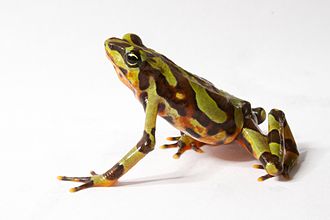Type the name of the breed you're looking for below
[wpdreams_ajaxsearchlite] Don't see the breed your're looking for? Click here and let us know!
Clown Tree Frog
| Place of Origin and Range | Once ranging from Costa Rica to Panama, the Clown Tree Frog is now listed as critically endangered and has been reduced to a single remnant population near Quepos, Costa Rica (rediscovered in 2003) and is presumed to be extinct in Panama. |
| Description | Has a dark body with odd shaped spots, light nose and dorsolateral stripes, spots on thigh, and orange fingers and toes. |
| Adult Size | Can grow up to 1 in(2.5 cm) |
| Accommodation | Hunting, courting, and sleeping in the trees, but as it is a small frog, it cannot jump far enough to span the distances between trees, so it returns to the ground to travel. Lots of branches for climbing and a moist substrate to keep high humidity. To prevent escape, many frog keepers move their amphibians in fine-meshed nets or with cupped hands. A partly terrestrial, partly arboreal enclosure should also be provided. Poison dart frogs may be small, but is very active and needs a suitably large terrarium (usually 100 x 60 x 60 cm) with a high level of humidity. Live plants should also be added to provide hiding places. |
| Lifespan | Unknown, believed to be 2+ years |
| Feeding / Diet | Feeds on termites, aphids, fruit flies, crickets, and any other small non-noxious insects. |
| Other Considerations | Like other poison dart frogs, it does not produce toxin in captivity. It probably gains its poison from consuming toxic insects or other invertebrates in the wild. |



